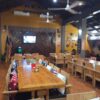Escolastica Tudela Cabrera, 81, narrates that incident in the cave in June 1944. Saipan was preparing for an invasion by the Americans and hiding in the caves, they could neither go out to fetch water nor to gather food. They resolved to stay inside the cave for their own safety.
They were so thirsty and they could not do anything to quench their thirst. Tan Escolastica says her sisters were so thirsty and they were crying. As the others in the cave tried to hush them for fear of being found and killed, her father told her sisters, “Never mind. Keep crying and drink your tears.”
And that’s what they did.
“They cried to have something to drink,” says Tan Escolastica.
There were neither coconuts nor sugarcanes to slake their thirst.
Tan Escolastica says she remembers full well how they spent 19 long days in a small cave where she huddled with 39 other family members and close friends, including a one-year-old baby who didn’t live long enough.
Born on February 10, 1930 to Vicente Ramirez Tudela and Rita Diaz Borja, Tan Escolastica still has a sharp recollection of what transpired not only those agonizing days in the cave but even more remarkable are her memories that go as far back as when she was five or six years old.
Initially, she says, she enrolled in a Catholic school when she was five or six years old, the equivalent of kindergarten.
At age 7, she had her first communion.
Then she went to Saipan koggako, a Japanese school in Garapan for her first grade.
It’s remarkable too how at 81 years old, she can still recite the names of her sensei — teachers — from first to third grade: Kaneko, Tominaga, and Sugaruma.
Asked how school was like during the pre-war years, she says, “It’s not bad. It’s very silent. We never knew anything about a war. We were just playing and studying.”
At Saipan kogakko, she says, they were taught reading, writing, arithmetic, storytelling, and farming. They would plant vegetables and flowers, she says.
“I remember we grew carnation. When the flowers bloomed, we cut them, bundled 10 pieces, and sold them to Japanaese officers’ wives for 10 cents a bundle,” recalls Tan Escolastica.
Aside from planting vegetables and flowers, she enjoys learning numbers and storytelling.
She also has fond memories of school programs where she was chosen to sing and dance.
Everything was relatively peaceful until she moved up to third grade.
Sensei Sugaruma, she describes, “was very, very bad.”
She even remembers that the teacher transferred from Kagman to Garapan and that he could possibly be a soldier.
“He’s very strict. He always likes to beat us up,” says Tan Escolastica.
Learning Nihongo at the time was mandatory and Tan Escolastica says they were even told to speak Japanese to their parents at home.
She confesses that there were mean teachers who asked them, “How do you like the Americans?” — a question they didn’t have an answer to as they had not seen an American at that time.
“It was like [answering the question] ‘How can you say you like the food when you have not tasted it,” she says.
She admits though that she knew of a Russian who owns a store in Garapan. She describes the Russian as “a nice-looking tall guy” from whose store she would buy every now and then.
Then the conversation with Tan Escolastica shifted to graduation.
She says she graduated at the top of her class and she received a diploma signed by no less than the Japanese Emperor Hirohito and the teachers.
Asked if she still has it, she says they lost everything they own except for the clothes they wore when they fled to the caves.
Prior to the invasion, in February 1944, she says there was a plane hovering and taking photos.
The Japanese, she says, were already talking about an imminent war and were distributing newsletters to their fellow Japanese, shutting out the Chamorros and Carolinians from ever finding out.
Although she speaks and reads Japanese, Tan Escolastica says the newsletters were in kanji. “I don’t know kanji, but I still remember katakana.”
She also remembers that in 1941, when the Japanese took Guam, the Japanese government made the men work in As Lito. Some smart men were recruited as translators and sent to Guam where they were reassigned as policemen and messengers, among other occupations needed at the time.
She remembers her two brothers were recruited and sent to Guam. Another brother worked in As Lito.
Again, the conversation shifted to 1944 when, after school, everyone were made to work at a planned airbase stretching from the area where Toyota Microl now stands up to the police station in Chalan Kanoa.
“They made us work at the airbase,” remembers Tan Escolastica as she talked about how they dug the sand with shovel and their bare hands. She says all women had to work, even the Japanese.
They worked with no pay at all. “We were forced to work.”
Then food and everything else were being rationed, she says.
Then just as the invasion was drawing near, everybody scuttled to the caves. She says they have a farm in As Teo.
Initially, she says, they were eyeing a big cave that can house 200 people.
But the Japanese kicked them out only to have the cave reserved for dispensary.
Describing the smaller caves, she says, “You cannot stand up. We were just sitting.”
Prior to occupying the caves, she says her father made leather from a cow’s skin and along with banana stalks covered their hiding place.
During the bombing of Saipan, she says, they were already at the farm where food and water were abundant. “We ate banana, taro, chicken, eggs, coconuts…to survive.”
She says her father’s farm sits next to Donni spring or “Saldok” in Chamorro. Even the Japanese at the time would fetch and bring water from the spring their ships at the port .
Despite having a spring nearby, they couldn’t get water as they holed up in the caves for 19 days.
As the bombings intensified, it was for their own safety that they had to fight off the gnawing pangs of hunger and thirst.
But not long after, the Americans found them and asked them to come out and come down to Susupe.
She remembers how an American soldier lifted their cave’s leather cover and out her mother went.
The soldiers asked who could speak either Spanish or Japanese, and her father volunteered and spoke to the soldiers in Spanish. “’Hablo español,’ he said. But I could not understand what they talked about,” says Tan Escolastica.
From the caves they moved to the spring but were warned not to drink water from it as two Japanese soldiers died in the water.
The American soldiers brought water and food to the local families.
Soon, everybody was hauled in the trucks and off they went to Camp Susupe.
Tan Escolastica says she saw dead bodies littering the roads on their way to the camp.
When they arrived at the camp, she had to deal with her period.
When they arrived at Camp Susupe, “there was plenty of people.”
She remembers how she hurriedly sought refuge in an abandoned Japanese house where she washed her dress and bathed.
She also recalls how her mother and her friends gathered pieces of cloth, needle and thread so she could sew a new dress.
The first few nights at the camp, she says, “we slept on top of sand. There was no mat available.”
She describes the camp as mixed up with no privacy.
Food was served with brown rice cooked in a massive cauldron. She also says they were given corned beef and they had no bread. They used the leaves of breadfruit as plates and ate with their bare hands.
As they staved off their hunger, they slaked their thirst with water from the well that resulted in many suffering from diarrhea.
The American Red Cross, Tan Escolastica says, responded immediately. She says they were examined, vaccinated and given medicines.
They were also treated for head lice infestation.
“The Americans tried to keep everyone clean,” she says.
Six months they stayed in the camp. The camp was segregated according to ethnic lines: Chamorros and Carolinians, Japanese, Koreans, and Okinawans.
After six long months, the gates of Camp Susupe were opened and they were set free — time to pick up the pieces and rebuild their lives.
And Chalan Kanoa was where the reconstruction began.
(To be continued)










